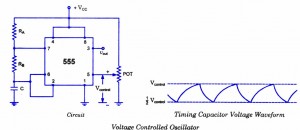A voltage-controlled oscillator (VCO) using the timer 555 is shown in figure.

The circuit is sometimes called a voltage-to-frequency converter because the output frequency can be changed by changing the input voltage.
As discussed in previous blog posts, pin 5 terminal is voltage control terminal and its function is to control the threshold and trigger levels. Normally, the control voltage is ++2/3VCC because of the internal voltage divider. However, an external voltage can be applied to this terminal directly or through a pot, as illustrated in figure, and by adjusting the pot, control voltage can be varied. Voltage across the timing capacitor is depicted in figure, which varies between +Vcontrol and ½ Vcontrol. If control voltage is increased, the capacitor takes a longer to charge and discharge; the frequency, therefore, decreases. Thus the frequency can be changed by changing the control voltage. Incidentally, the control voltage may be made available through a pot, or it may be output of a transistor circuit, op-amp, or some other device.

2 Comments
Please submit the Ossillator [voc] component list.
This is a so much more affordable Voltage to Frequency solution then many of the chips out there that are designed specifically for this purpose. I have great plans for this. I may add a transistor to the cap charge part of the circuit to get a linear relationship from the voltage input to frequency output. Like in “Ramp Generator Circuit-using 555 Timer IC”. What does anyone else think??
Stephen Payne